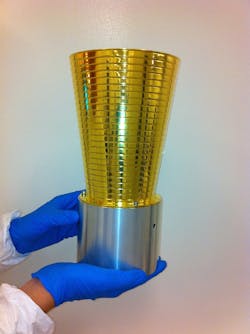Mirror Advances: Laser Gold lunar retroreflector to improve dark-matter understanding

The retroreflectors deployed on the moon during the Apollo missions have enhanced our understanding of everything from lunar tidal fluctuations to Einstein’s theory of general relativity. And in 2016, the “Lunar Laser Retro Reflector Array for the 21st Century” (LLRRA-21) will gather scientific data that could further improve our understanding of gravitation and general relativity and, as a result, dark energy and dark matter.
Douglas Currie, professor of physics at the University of Maryland (College Park, MD), a principal of the team that developed the Apollo arrays, approached Epner Technology (Brooklyn, NY) to apply its Laser Gold technology—a plating process known for its highly efficient reflection of infrared thermal radiation and extremely low emissivity—in the design of a new retroreflector package for the LLRRA-21 that will help investigate the “dark side.” The retroreflector is expected to be deployed on the lunar surface by Moon Express (Mountain View, CA), a company that is competing for the Google Lunar X Prize.
Isolating time wiggles
Dark matter is still a mystery, known only by its ability to bend light rays from distant galaxies; dark energy is yet another mystery, known only through observations of the acceleration of deep-space galaxies.
The LLRRA-21 will measure the approximately 2.5 s between transmission and reception of the laser pulse with extreme accuracy (one part in 1 trillion) to determine distance. These measurements are then repeated to form a time series. The different frequency components (wiggles) in this time record represent different physical phenomena. For example, a frequency of approximately 29.5 days is related to a polarization of the lunar orbit, which addresses the weak equivalence principle (Galileo’s principle that all objects fall at the same rate) and demonstrates that gravitational energy has inertial properties.
Properties of this type are critical to understanding dark matter/energy science. In particular, these data on the properties of gravitation and general relativity permit the elimination of some of the many theories that have been proposed to explain dark energy and dark matter.
Epner’s Laser Gold and a specialized silver coating protect the cube corner retroreflector from the day/night temperatures that range from 70 K to 350 K (see figure). Laser Gold, on an electroformed conformal heat shield, will be expected to control heat flow by keeping the internal temperature gradients to less than 0.2 K through most of the lunar month. Epner’s electroforming process produces an extremely dense coating that in turn results in extremely low emissivity that slows the transfer of heat and keeps the internal temperature gradient acceptably low.
Not yet part of the final design, a sun-shield is being explored that could block the sun’s rays from entering the cube corner reflector. This sunshield, like the retroreflector itself, is created by electroplating Laser Gold over a polished, fluted aluminum mandrel or tool. Following the gold, a 0.5-mm-thick layer of plated nickel is applied and the aluminum tool is then chemically etched away. The extremely lightweight sunshield has enough structural integrity to withstand the rigors of launch while functioning at an emissivity of less than 0.02.
“The unique characteristics of these high-density electrodeposited gold and silver coatings are critical to a successful development of this experiment to address the fundamental characteristics of the cosmos,” says professor Currie.

Gail Overton | Senior Editor (2004-2020)
Gail has more than 30 years of engineering, marketing, product management, and editorial experience in the photonics and optical communications industry. Before joining the staff at Laser Focus World in 2004, she held many product management and product marketing roles in the fiber-optics industry, most notably at Hughes (El Segundo, CA), GTE Labs (Waltham, MA), Corning (Corning, NY), Photon Kinetics (Beaverton, OR), and Newport Corporation (Irvine, CA). During her marketing career, Gail published articles in WDM Solutions and Sensors magazine and traveled internationally to conduct product and sales training. Gail received her BS degree in physics, with an emphasis in optics, from San Diego State University in San Diego, CA in May 1986.